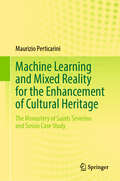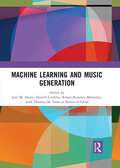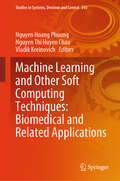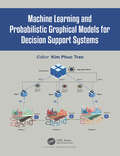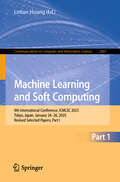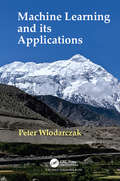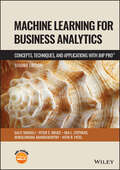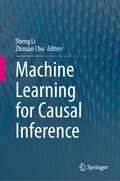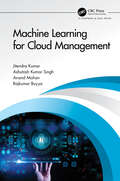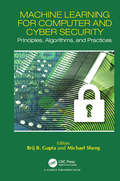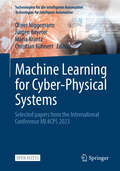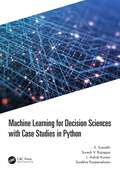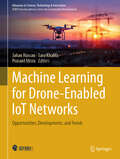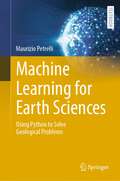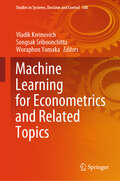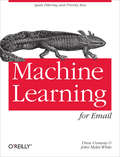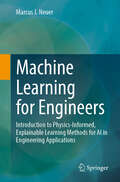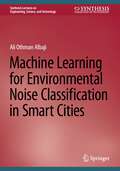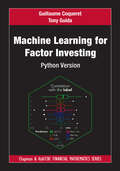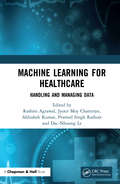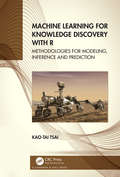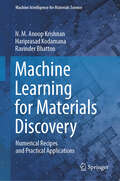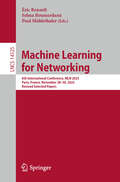- Table View
- List View
Machine Learning and Mixed Reality for the Enhancement of Cultural Heritage: The Monastery of Saints Severino and Sossio Case Study
by Maurizio PerticariniThis book addresses the role of modern surveying and representation technologies in preserving and disseminating cultural heritage. A workflow is illustrated, describing the Former Monastery of Ss Severino and Sossio case study, currently the headquarters of the State Archives of Naples, Italy. After offering a historical overview, the work examines the spaces and structure of the building. A methodology for three-dimensional restitution is presented, using low-cost image-based and professional range-based surveying, concluding with recent AI technologies such as NeRF. The research continues with the virtual and augmented restitution of parts of the building that have been modified, lost over the centuries, or are no longer accessible. The Atrio dei Marmi, the Atrio del Platano, and the Sala del Capitolo and Sala del Refettorio are some of the places where the research has focused, creating a BIM model, using AR for precise interventions, and developing an immersive applied game to understand the third level of the monastery, rich in works of art and today also serving as a museum. In the final chapters, a particular focus is placed on the future of representation: new techniques, ongoing developments in AI supporting surveying, and the new possibilities offered by virtual spaces.
Machine Learning and Music Generation
by José M. Iñesta, Darrell Conklin, Rafael Ramírez-Melendez, with Thomas M. Fiore as Editor-in-ChiefComputational approaches to music composition and style imitation have engaged musicians, music scholars, and computer scientists since the early days of computing. Music generation research has generally employed one of two strategies: knowledge-based methods that model style through explicitly formalized rules, and data mining methods that apply machine learning to induce statistical models of musical style. The five chapters in this book illustrate the range of tasks and design choices in current music generation research applying machine learning techniques and highlighting recurring research issues such as training data, music representation, candidate generation, and evaluation. The contributions focus on different aspects of modeling and generating music, including melody, chord sequences, ornamentation, and dynamics. Models are induced from audio data or symbolic data. This book was originally published as a special issue of the Journal of Mathematics and Music.
Machine Learning and Optimization for Engineering Design (Engineering Optimization: Methods and Applications)
by Apoorva S. Shastri Mangal Singh Kailash ShawThis book aims to provide a collection of state-of-the-art scientific and technical research papers related to machine learning-based algorithms in the field of optimization and engineering design. The theoretical and practical development for numerous engineering applications such as smart homes, ICT-based irrigation systems, academic success prediction, future agro-industry for crop production, disease classification in plants, dental problems and solutions, loan eligibility processing, etc., and their implementation with several case studies and literature reviews are included as self-contained chapters. Additionally, the book intends to highlight the importance of study and effectiveness in addressing the time and space complexity of problems and enhancing accuracy, analysis, and validations for different practical applications by acknowledging the state-of-the-art literature survey. The book targets a larger audience by exploring multidisciplinary research directions such as computer vision, machine learning, artificial intelligence, modified/newly developed machine learning algorithms, etc., to enhance engineering design applications for society. State-of-the-art research work with illustrations and exercises along with pseudo-code has been provided here.
Machine Learning and Other Soft Computing Techniques: Biomedical and Related Applications (Studies in Systems, Decision and Control #543)
by Vladik Kreinovich Nguyen Hoang Phuong Nguyen Thi Huyen ChauThis book contains applications to various health-related problems, from designing and maintaining a proper diet to enhancing hygiene to analysis of mammograms and left-right brain activity to treating diseases such as diabetes and drug addictions. Health issues are very important. So naturally whatever new data processing technique appears, researchers try to apply it to health issues as well. From this viewpoint, Artificial Intelligence (AI) and Computational Intelligence (CI) techniques are no exception: they have been successfully applied to medicine, and more promising applications are on the way. Applications of AI and CI techniques to health issues are the main focus of this book. Health issues are also very delicate, because human bodies are complex organisms. No matter how interesting and promising are new ideas and new techniques, there is always a possibility of unexpected side effects. Because of this, we cannot apply untested methods to patients, and we first need to test these methods on other less critical applications. Several book chapters describe such applications—whose success paves the way for these methods to be used in biomedical situations. These applications range from human/face detection to predicting student success to predicting election results to explaining the observed intensity of space light. We hope that this book helps practitioners and researchers to learn more about computational intelligence techniques and their biomedical applications—and to further develop this important research direction.
Machine Learning and Probabilistic Graphical Models for Decision Support Systems
by Kim Phuc TranThis book presents recent advancements in research, a review of new methods and techniques, and applications in decision support systems (DSS) with Machine Learning and Probabilistic Graphical Models, which are very effective techniques in gaining knowledge from Big Data and in interpreting decisions. It explores Bayesian network learning, Control Chart, Reinforcement Learning for multicriteria DSS, Anomaly Detection in Smart Manufacturing with Federated Learning, DSS in healthcare, DSS for supply chain management, etc. Researchers and practitioners alike will benefit from this book to enhance the understanding of machine learning, Probabilistic Graphical Models, and their uses in DSS in the context of decision making with uncertainty. The real-world case studies in various fields with guidance and recommendations for the practical applications of these studies are introduced in each chapter.
Machine Learning and Soft Computing: 9th International Conference, ICMLSC 2025, Tokyo, Japan, January 24–26, 2025, Revised Selected Papers, Part I (Communications in Computer and Information Science #2487)
by Letian HuangThis two part-volume CCIS constitutes the refereed proceedings of 9th International Conference, ICMLSC 2025, in Tokyo, Japan in January 24–26, 2025. The 39 full papers and 13 short papers included in this book were carefully reviewed and selected from 121 submissions. They follow the topical sections as below: Part I : Multimodal Data Analysis and Model Optimization; Basic Theories of Machine Learning and Emerging Application Technologies; and Intelligent Recommendation System Design and Privacy Security. Part II : Deep Learning Models and High-performance Computing; Data-driven Complex System Modeling and Intelligent Optimization Algorithms; and Image Analysis and Processing Methods based on AI.
Machine Learning and its Applications
by Peter WlodarczakIn recent years, machine learning has gained a lot of interest. Due to the advances in processor technology and the availability of large amounts of data, machine learning techniques have provided astounding results in areas such as object recognition or natural language processing. New approaches, e.g. deep learning, have provided groundbreaking outcomes in fields such as multimedia mining or voice recognition. Machine learning is now used in virtually every domain and deep learning algorithms are present in many devices such as smartphones, cars, drones, healthcare equipment, or smart home devices. The Internet, cloud computing and the Internet of Things produce a tsunami of data and machine learning provides the methods to effectively analyze the data and discover actionable knowledge. This book describes the most common machine learning techniques such as Bayesian models, support vector machines, decision tree induction, regression analysis, and recurrent and convolutional neural networks. It first gives an introduction into the principles of machine learning. It then covers the basic methods including the mathematical foundations. The biggest part of the book provides common machine learning algorithms and their applications. Finally, the book gives an outlook into some of the future developments and possible new research areas of machine learning and artificial intelligence in general. This book is meant to be an introduction into machine learning. It does not require prior knowledge in this area. It covers some of the basic mathematical principle but intends to be understandable even without a background in mathematics. It can be read chapter wise and intends to be comprehensible, even when not starting in the beginning. Finally, it also intends to be a reference book. Key Features: Describes real world problems that can be solved using Machine Learning Provides methods for directly applying Machine Learning techniques to concrete real world problems Demonstrates how to apply Machine Learning techniques using different frameworks such as TensorFlow, MALLET, R
Machine Learning for Business Analytics: Concepts, Techniques and Applications with JMP Pro
by Galit Shmueli Peter C. Bruce Nitin R. Patel Mia L. Stephens Muralidhara AnandamurthyMACHINE LEARNING FOR BUSINESS ANALYTICS An up-to-date introduction to a market-leading platform for data analysis and machine learning Machine Learning for Business Analytics: Concepts, Techniques, and Applications with JMP Pro®, 2nd ed. offers an accessible and engaging introduction to machine learning. It provides concrete examples and case studies to educate new users and deepen existing users’ understanding of their data and their business. Fully updated to incorporate new topics and instructional material, this remains the only comprehensive introduction to this crucial set of analytical tools specifically tailored to the needs of businesses. Machine Learning for Business Analytics: Concepts, Techniques, and Applications with JMP Pro®, 2nd ed. readers will also find: Updated material which improves the book’s usefulness as a reference for professionals beyond the classroom Four new chapters, covering topics including Text Mining and Responsible Data Science An updated companion website with data sets and other instructor resources: www.jmp.com/dataminingbook A guide to JMP Pro®’s new features and enhanced functionality Machine Learning for Business Analytics: Concepts, Techniques, and Applications with JMP Pro®, 2nd ed. is ideal for students and instructors of business analytics and data mining classes, as well as data science practitioners and professionals in data-driven industries.
Machine Learning for Causal Inference
by Sheng Li Zhixuan ChuThis book provides a deep understanding of the relationship between machine learning and causal inference. It covers a broad range of topics, starting with the preliminary foundations of causal inference, which include basic definitions, illustrative examples, and assumptions. It then delves into the different types of classical causal inference methods, such as matching, weighting, tree-based models, and more. Additionally, the book explores how machine learning can be used for causal effect estimation based on representation learning and graph learning. The contribution of causal inference in creating trustworthy machine learning systems to accomplish diversity, non-discrimination and fairness, transparency and explainability, generalization and robustness, and more is also discussed. The book also provides practical applications of causal inference in various domains such as natural language processing, recommender systems, computer vision, time series forecasting, and continual learning. Each chapter of the book is written by leading researchers in their respective fields. Machine Learning for Causal Inference explores the challenges associated with the relationship between machine learning and causal inference, such as biased estimates of causal effects, untrustworthy models, and complicated applications in other artificial intelligence domains. However, it also presents potential solutions to these issues. The book is a valuable resource for researchers, teachers, practitioners, and students interested in these fields. It provides insights into how combining machine learning and causal inference can improve the system's capability to accomplish causal artificial intelligence based on data. The book showcases promising research directions and emphasizes the importance of understanding the causal relationship to construct different machine-learning models from data.
Machine Learning for Cloud Management
by Rajkumar Buyya Jitendra Kumar Anand Mohan Ashutosh Kumar SinghCloud computing offers subscription-based on-demand services, and it has emerged as the backbone of the computing industry. It has enabled us to share resources among multiple users through virtualization, which creates a virtual instance of a computer system running in an abstracted hardware layer. Unlike early distributed computing models, it offers virtually limitless computing resources through its large scale cloud data centers. It has gained wide popularity over the past few years, with an ever-increasing infrastructure, a number of users, and the amount of hosted data. The large and complex workloads hosted on these data centers introduce many challenges, including resource utilization, power consumption, scalability, and operational cost. Therefore, an effective resource management scheme is essential to achieve operational efficiency with improved elasticity. Machine learning enabled solutions are the best fit to address these issues as they can analyze and learn from the data. Moreover, it brings automation to the solutions, which is an essential factor in dealing with large distributed systems in the cloud paradigm. Machine Learning for Cloud Management explores cloud resource management through predictive modelling and virtual machine placement. The predictive approaches are developed using regression-based time series analysis and neural network models. The neural network-based models are primarily trained using evolutionary algorithms, and efficient virtual machine placement schemes are developed using multi-objective genetic algorithms. Key Features: the first book to set out a range of machine learning methods for efficient resource management in a large distributed network of clouds. predictive analytics is an integral part of efficient cloud resource management, and this book gives a future research direction to researchers in this domain. it is written by leading international researchers. The book is ideal for researchers who are working in the domain of cloud computing.
Machine Learning for Computer and Cyber Security: Principle, Algorithms, and Practices (Cyber Ecosystem And Security Ser.)
by Quan Z. Sheng Brij B. GuptaWhile Computer Security is a broader term which incorporates technologies, protocols, standards and policies to ensure the security of the computing systems including the computer hardware, software and the information stored in it, Cyber Security is a specific, growing field to protect computer networks (offline and online) from unauthorized access, botnets, phishing scams, etc. Machine learning is a branch of Computer Science which enables computing machines to adopt new behaviors on the basis of observable and verifiable data and information. It can be applied to ensure the security of the computers and the information by detecting anomalies using data mining and other such techniques. <P><P>This book will be an invaluable resource to understand the importance of machine learning and data mining in establishing computer and cyber security. It emphasizes important security aspects associated with computer and cyber security along with the analysis of machine learning and data mining based solutions. The book also highlights the future research domains in which these solutions can be applied. Furthermore, it caters to the needs of IT professionals, researchers, faculty members, scientists, graduate students, research scholars and software developers who seek to carry out research and develop combating solutions in the area of cyber security using machine learning based approaches. It is an extensive source of information for the readers belonging to the field of Computer Science and Engineering, and Cyber Security professionals. <P><P>Key Features: <li>This book contains examples and illustrations to demonstrate the principles, algorithms, challenges and applications of machine learning and data mining for computer and cyber security. <li>It showcases important security aspects and current trends in the field. <li>It provides an insight of the future research directions in the field. <P><P>Contents of this book help to prepare the students for exercising better defense in terms of understanding the motivation of the attackers and how to deal with and mitigate the situation using machine learning based approaches in better manner.
Machine Learning for Cyber Physical System: Advances and Challenges (Intelligent Systems Reference Library #60)
by Margarita Favorskaya Janmenjoy Nayak Bighnaraj Naik Vimal S.This book provides a comprehensive platform for learning the state-of-the-art machine learning algorithms for solving several cybersecurity issues. It is helpful in guiding for the implementation of smart machine learning solutions to detect various cybersecurity problems and make the users to understand in combating malware, detect spam, and fight financial fraud to mitigate cybercrimes. With an effective analysis of cyber-physical data, it consists of the solution for many real-life problems such as anomaly detection, IoT-based framework for security and control, manufacturing control system, fault detection, smart cities, risk assessment of cyber-physical systems, medical diagnosis, smart grid systems, biometric-based physical and cybersecurity systems using advance machine learning approach. Filling an important gap between machine learning and cybersecurity communities, it discusses topics covering a wide range of modern and practical advance machine learning techniques, frameworks, and development tools to enable readers to engage with the cutting-edge research across various aspects of cybersecurity.
Machine Learning for Cyber-Physical Systems: Selected papers from the International Conference ML4CPS 2023 (Technologien für die intelligente Automation #18)
by Jürgen Beyerer Oliver Niggemann Christian Kühnert Maria KrantzThis open access proceedings presents new approaches to Machine Learning for Cyber-Physical Systems, experiences and visions. It contains some selected papers from the international Conference ML4CPS – Machine Learning for Cyber-Physical Systems, which was held in Hamburg (Germany), March 29th to 31st, 2023. Cyber-physical systems are characterized by their ability to adapt and to learn: They analyze their environment and, based on observations, they learn patterns, correlations and predictive models. Typical applications are condition monitoring, predictive maintenance, image processing and diagnosis. Machine Learning is the key technology for these developments.This is an open access book.
Machine Learning for Decision Sciences with Case Studies in Python
by S. Sumathi Suresh Rajappa L Ashok Kumar Surekha PaneerselvamThis book provides a detailed description of machine learning algorithms in data analytics, data science life cycle, Python for machine learning, linear regression, logistic regression, and so forth. It addresses the concepts of machine learning in a practical sense providing complete code and implementation for real-world examples in electrical, oil and gas, e-commerce, and hi-tech industries. The focus is on Python programming for machine learning and patterns involved in decision science for handling data. Features: Explains the basic concepts of Python and its role in machine learning. Provides comprehensive coverage of feature engineering including real-time case studies. Perceives the structural patterns with reference to data science and statistics and analytics. Includes machine learning-based structured exercises. Appreciates different algorithmic concepts of machine learning including unsupervised, supervised, and reinforcement learning. This book is aimed at researchers, professionals, and graduate students in data science, machine learning, computer science, and electrical and computer engineering.
Machine Learning for Drone-Enabled IoT Networks: Opportunities, Developments, and Trends (Advances in Science, Technology & Innovation)
by Sara Khalifa Jahan Hassan Prasant MisraThis book aims to explore the latest developments, challenges, and opportunities in the application of machine learning techniques to enhance the performance and efficiency of IoT networks assisted by aerial unmanned vehicles (UAVs), commonly known as drones. The book aims to include cutting edge research and development on a number of areas within the topic including but not limited to: •Machine learning algorithms for drone-enabled IoT networks •Sensing and data collection with drones for IoT applications •Data analysis and processing for IoT networks assisted by drones •Energy-efficient and scalable solutions for drone-assisted IoT networks •Security and privacy issues in drone-enabled IoT networks •Emerging trends and future directions in ML for drone-assisted IoT networks.
Machine Learning for Earth Sciences: Using Python to Solve Geological Problems (Springer Textbooks in Earth Sciences, Geography and Environment)
by Maurizio PetrelliThis textbook introduces the reader to Machine Learning (ML) applications in Earth Sciences. In detail, it starts by describing the basics of machine learning and its potentials in Earth Sciences to solve geological problems. It describes the main Python tools devoted to ML, the typival workflow of ML applications in Earth Sciences, and proceeds with reporting how ML algorithms work. The book provides many examples of ML application to Earth Sciences problems in many fields, such as the clustering and dimensionality reduction in petro-volcanological studies, the clustering of multi-spectral data, well-log data facies classification, and machine learning regression in petrology. Also, the book introduces the basics of parallel computing and how to scale ML models in the cloud. The book is devoted to Earth Scientists, at any level, from students to academics and professionals.
Machine Learning for Econometrics and Related Topics (Studies in Systems, Decision and Control #508)
by Vladik Kreinovich Songsak Sriboonchitta Woraphon YamakaIn the last decades, machine learning techniques – especially techniques of deep learning – led to numerous successes in many application areas, including economics. The use of machine learning in economics is the main focus of this book; however, the book also describes the use of more traditional econometric techniques. Applications include practically all major sectors of economics: agriculture, health (including the impact of Covid-19), manufacturing, trade, transportation, etc. Several papers analyze the effect of age, education, and gender on economy – and, more generally, issues of fairness and discrimination.We hope that this volume will:help practitioners to become better knowledgeable of the state-of-the-art econometric techniques, especially techniques of machine learning,and help researchers to further develop these important research directions. We want to thank all the authors for their contributions and all anonymous referees for their thorough analysis and helpful comments.
Machine Learning for Email: Spam Filtering and Priority Inbox
by John Myles White Drew ConwayIf you’re an experienced programmer willing to crunch data, this concise guide will show you how to use machine learning to work with email. You’ll learn how to write algorithms that automatically sort and redirect email based on statistical patterns. Authors Drew Conway and John Myles White approach the process in a practical fashion, using a case-study driven approach rather than a traditional math-heavy presentation.This book also includes a short tutorial on using the popular R language to manipulate and analyze data. You’ll get clear examples for analyzing sample data and writing machine learning programs with R.Mine email content with R functions, using a collection of sample filesAnalyze the data and use the results to write a Bayesian spam classifierRank email by importance, using factors such as thread activityUse your email ranking analysis to write a priority inbox programTest your classifier and priority inbox with a separate email sample set
Machine Learning for Engineers: Introduction to Physics-Informed, Explainable Learning Methods for AI in Engineering Applications
by Marcus J. NeuerMachine learning and artificial intelligence are ubiquitous terms for improving technical processes. However, practical implementation in real-world problems is often difficult and complex. This textbook explains learning methods based on analytical concepts in conjunction with complete programming examples in Python, always referring to real technical application scenarios. It demonstrates the use of physics-informed learning strategies, the incorporation of uncertainty into modeling, and the development of explainable, trustworthy artificial intelligence with the help of specialized databases. Therefore, this textbook is aimed at students of engineering, natural science, medicine, and business administration as well as practitioners from industry (especially data scientists), developers of expert databases, and software developers.
Machine Learning for Environmental Noise Classification in Smart Cities (Synthesis Lectures on Engineering, Science, and Technology)
by Ali Othman AlbajiWe present a Machine Learning (ML) approach to monitoring and classifying noise pollution. Both methods of monitoring and classification have been proven successful. MATLAB and Python code was generated to monitor all types of noise pollution from the collected data, while ML was trained to classify these data. ML algorithms showed promising performance in monitoring the different sound classes such as highways, railways, trains and birds, airports and many more. It is observed that all the data obtained by both methods can be used to control noise pollution levels and for data analytics. They can help decision making and policy making by stakeholders such as municipalities, housing authorities and urban planners in smart cities. The findings indicate that ML can be used effectively in monitoring and measurement. Improvements can be obtained by enhancing the data collection methods. The intention is to develop more ML platforms from which to construct a less noisy. The second objective of this study was to visualize and analyze the data of 18 types of noise pollution that have been collected from 16 different locations in Malaysia. All the collected data were stored in Tableau software. Through the use of both qualitative and quantitative measurements, the data collected for this project was then combined to create a noise map database that can help smart cities make informed decisions.
Machine Learning for Factor Investing: Python Version (Chapman and Hall/CRC Financial Mathematics Series)
by Tony Guida Guillaume CoqueretMachine learning (ML) is progressively reshaping the fields of quantitative finance and algorithmic trading. ML tools are increasingly adopted by hedge funds and asset managers, notably for alpha signal generation and stocks selection. The technicality of the subject can make it hard for non-specialists to join the bandwagon, as the jargon and coding requirements may seem out-of-reach. Machine learning for factor investing: Python version bridges this gap. It provides a comprehensive tour of modern ML-based investment strategies that rely on firm characteristics. The book covers a wide array of subjects which range from economic rationales to rigorous portfolio back-testing and encompass both data processing and model interpretability. Common supervised learning algorithms such as tree models and neural networks are explained in the context of style investing and the reader can also dig into more complex techniques like autoencoder asset returns, Bayesian additive trees and causal models. All topics are illustrated with self-contained Python code samples and snippets that are applied to a large public dataset that contains over 90 predictors. The material, along with the content of the book, is available online so that readers can reproduce and enhance the examples at their convenience. If you have even a basic knowledge of quantitative finance, this combination of theoretical concepts and practical illustrations will help you learn quickly and deepen your financial and technical expertise.
Machine Learning for Healthcare: Handling and Managing Data
by Rashmi Agrawal, Jyotir Moy Chatterjee, Abhishek Kumar, Pramod Singh Rathore and Dac-Nhuong LeMachine Learning for Healthcare: Handling and Managing Data provides in-depth information about handling and managing healthcare data through machine learning methods. This book expresses the long-standing challenges in healthcare informatics and provides rational explanations of how to deal with them. Machine Learning for Healthcare: Handling and Managing Data provides techniques on how to apply machine learning within your organization and evaluate the efficacy, suitability, and efficiency of machine learning applications. These are illustrated in a case study which examines how chronic disease is being redefined through patient-led data learning and the Internet of Things. This text offers a guided tour of machine learning algorithms, architecture design, and applications of learning in healthcare. Readers will discover the ethical implications of machine learning in healthcare and the future of machine learning in population and patient health optimization. This book can also help assist in the creation of a machine learning model, performance evaluation, and the operationalization of its outcomes within organizations. It may appeal to computer science/information technology professionals and researchers working in the area of machine learning, and is especially applicable to the healthcare sector. The features of this book include: A unique and complete focus on applications of machine learning in the healthcare sector. An examination of how data analysis can be done using healthcare data and bioinformatics. An investigation of how healthcare companies can leverage the tapestry of big data to discover new business values. An exploration of the concepts of machine learning, along with recent research developments in healthcare sectors.
Machine Learning for Knowledge Discovery with R: Methodologies for Modeling, Inference and Prediction
by Kao-Tai TsaiMachine Learning for Knowledge Discovery with R contains methodologies and examples for statistical modelling, inference, and prediction of data analysis. It includes many recent supervised and unsupervised machine learning methodologies such as recursive partitioning modelling, regularized regression, support vector machine, neural network, clustering, and causal-effect inference. Additionally, it emphasizes statistical thinking of data analysis, use of statistical graphs for data structure exploration, and result presentations. The book includes many real-world data examples from life-science, finance, etc. to illustrate the applications of the methods described therein. Key Features: Contains statistical theory for the most recent supervised and unsupervised machine learning methodologies. Emphasizes broad statistical thinking, judgment, graphical methods, and collaboration with subject-matter-experts in analysis, interpretation, and presentations. Written by statistical data analysis practitioner for practitioners. The book is suitable for upper-level-undergraduate or graduate-level data analysis course. It also serves as a useful desk-reference for data analysts in scientific research or industrial applications.
Machine Learning for Materials Discovery: Numerical Recipes and Practical Applications (Machine Intelligence for Materials Science)
by Hariprasad Kodamana Ravinder Bhattoo N. M. KrishnanFocusing on the fundamentals of machine learning, this book covers broad areas of data-driven modeling, ranging from simple regression to advanced machine learning and optimization methods for applications in materials modeling and discovery. The book explains complex mathematical concepts in a lucid manner to ensure that readers from different materials domains are able to use these techniques successfully. A unique feature of this book is its hands-on aspect—each method presented herein is accompanied by a code that implements the method in open-source platforms such as Python. This book is thus aimed at graduate students, researchers, and engineers to enable the use of data-driven methods for understanding and accelerating the discovery of novel materials.
Machine Learning for Networking: 6th International Conference, MLN 2023, Paris, France, November 28–30, 2023, Revised Selected Papers (Lecture Notes in Computer Science #14525)
by Selma Boumerdassi Éric Renault Paul MühlethalerThis book constitutes the refereed proceedings of the 6th International Conference on Machine Learning for Networking, MLN 2023, held in Paris, France, during November 28–30, 2023. The 18 full papers included in this book were carefully reviewed and selected from 34 submissions. The conference aims at providing a top forum for researchers and practitioners to present and discuss new trends in machine learning, deep learning, pattern recognition and optimization for network architectures and services.
